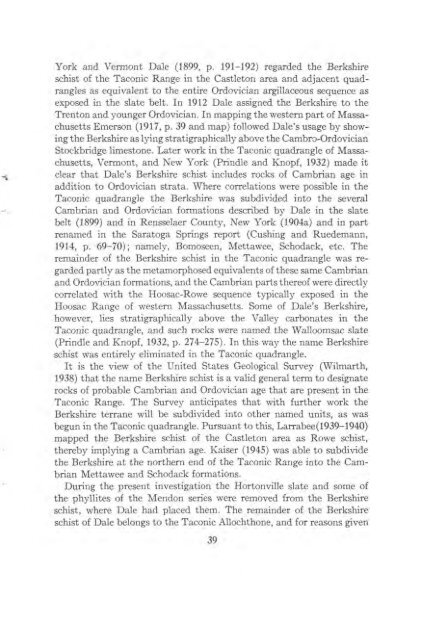STRATIGRAPHY AND STRUCTURE CASTLETON AREA VERMONT
STRATIGRAPHY AND STRUCTURE CASTLETON AREA VERMONT
STRATIGRAPHY AND STRUCTURE CASTLETON AREA VERMONT
You also want an ePaper? Increase the reach of your titles
YUMPU automatically turns print PDFs into web optimized ePapers that Google loves.
York and Vermont Dale (1899, P. 191-192) regarded the Berkshire<br />
schist of the Taconic Range in the Castleton area and adjacent quadrangles<br />
as equivalent to the entire Ordovician argillaceous sequence as<br />
exposed in the slate belt. In 1912 Dale assigned the Berkshire to the<br />
Trenton and younger Ordovician. In mapping the western part of Massachusetts<br />
Emerson (1917, p. 39 and map) followed Dale's usage by showing<br />
the Berkshire as lying stratigraphically above the Cambro-Ordovician<br />
Stockbridge limestone. Later work in the Taconic quadrangle of Massachusetts,<br />
Vermont, and New York (Prindle and Knopf, 1932) made it<br />
clear that Dale's Berkshire schist includes rocks of Cambrian age in<br />
addition to Ordovician strata. Where correlations were possible in the<br />
Taconic quadrangle the Berkshire was subdivided into the several<br />
Cambrian and Ordovician formations described by Dale in the slate<br />
belt (1899) and in Rensselaer County, New York (1904a) and in part<br />
renamed in the Saratoga Springs report (Cushing and Ruedemann,<br />
1914, p. 69-70); namely, Bomoseen, Mettawee, Schodack, etc. The<br />
remainder of the Berkshire schist in the Taconic quadrangle was regarded<br />
partly as the metamorphosed equivalents of these same Cambrian<br />
and Ordovician formations, and the Cambrian parts thereof were directly<br />
correlated with the Hoosac-Rowe sequence typically exposed in the<br />
Hoosac Range of western Massachusetts. Some of Dale's Berkshire,<br />
however, lies stratigraphically above the Valley carbonates in the<br />
Taconic quadrangle, and such rocks were named the Walloomsac slate<br />
(Prindle and Knopf, 1932, p. 274-275). In this way the name Berkshire<br />
schist was entirely eliminated in the Taconic quadrangle.<br />
It is the view of the United States Geological Survey (Wilmarth,<br />
1938) that the name Berkshire schist is a valid general term to designate<br />
rocks of probable Cambrian and Ordovician age that are present in the<br />
Taconic Range. The Survey anticipates that with further work the<br />
Berkshire terrane will be subdivided into other named units, as was<br />
begun in the Taconic quadrangle. Pursuant to this, Larrabee(1939-1940)<br />
mapped the Berkshire schist of the Castleton area as Rowe schist,<br />
thereby implying a Cambrian age. Kaiser (1945) was able to subdivide<br />
the Berkshire at the northern end of the Taconic Range into the Cambrian<br />
Mettawee and Schodack formations.<br />
During the present investigation the Hortonville slate and some of<br />
the phyllites of the Mendon series were removed from the Berkshire<br />
schist, where Dale had placed them. The remainder of the Berkshire<br />
schist of Dale belongs to the Taconic Allochthone, and for reasons given<br />
39













